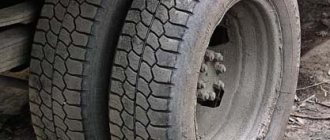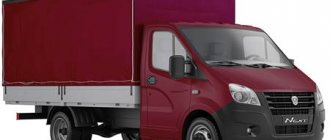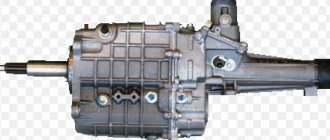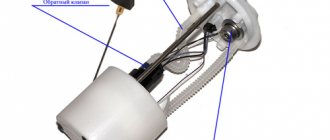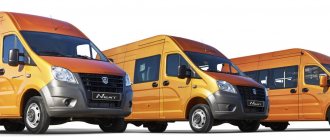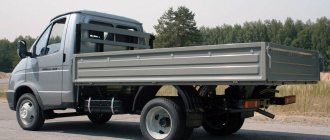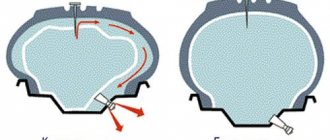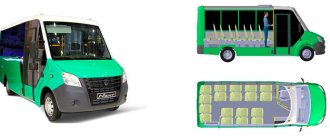Model features
GA3-2705 vehicles are aimed at meeting the needs of small and medium-sized businesses. The van has a small carrying capacity, which allows it to be used in central areas of cities, and to drive such a truck, a “passenger” category “B” is sufficient. GAZelles are not subject to the traffic regulations sign 3.4 “Traffic traffic is prohibited” (if the sign does not have an additional designation of the vehicle’s weight). GA3el cars belong to class N1 (M2) with a permitted maximum weight not exceeding 3500 kilograms.
In addition to two cabin doors, the car is equipped with two cargo doors - a side sliding compartment door and a rear double-hinged door that opens 180 degrees.
For those organizations that need to transport both a small group of passengers (for example, a work crew) and a consignment of cargo at the same time, the cargo-passenger GA3-2705 (combi option) has become the optimal option. The all-metal compartment of the van protects the cargo well from dirt, dust and adverse climatic conditions. These trucks demonstrated good adaptation to the difficult conditions of imperfect domestic roads and decent endurance.
Initially, the all-metal GA3el vans received a rather modest exterior and interior – with simple rectangular optics, a radiator grille and side mirrors that left significant “dead zones”; an angular dashboard made of cheap plastic and interior trim with other economy-class materials.
In 2003, the GA3el family was restyled. The new cars were noticeably different in appearance from the earlier series with a new tail, radiator grille, bumper and lighting equipment (before restyling, the headlights were rectangular, after they became streamlined, teardrop-shaped). The side mirrors have become larger, complemented by integrated turn signal indicators. Since February 2010, production of an improved version of the car began, called “GA3el Business” (the second restyling of “GA3el”). The number of modifications of GA3-2705 / “GA3el Business” is ten: cargo and cargo-passenger; with petrol, diesel and gas engines.
The cargo version of the van does not have glazing. Additional viewing side windows are installed only on cargo-passenger versions of the “combi” - for passengers of the second row of seats. The cargo-passenger version, which is no different from a van according to the basic industry index, is equipped with an additional seat for four passengers and a solid partition separating the cabin from the cargo compartment.
Among the unusual modifications of this family are the GA3-27057 all-terrain van, as well as the GA3-2705-90 and GA3-27057-90 variants: with an add-on plastic roof, increasing the internal height of the cargo compartment from 1515 to 1850 mm and its useful volume from 9- from m³ to 11 m³.
First generation (1995-2003).
Based on the basic version of GA3-2705, many special vehicles were developed for various highly specialized purposes (cash-in-transit armored vehicles, ambulances and intensive care vehicles, auto laboratories, etc.)
Since 2013, the production of GA3el trucks of a new generation began: GA3el-Next. The car inherited the frame, gearbox and rear axle from the “classic” GAZelle. The classic "GAZelle" family also remained in the production program of the Gorky Automobile Plant, and after the release of the new "Next" family, it received a number of improvements and the name "GA3el Business"
Purpose
The Gazelle car has a large number of modifications and is quite picky both to the quality of the spare parts used and to the operating conditions. Its modifications include:
- "Gazelle Business" has a closed body, which is considered a cargo compartment.
- “Gazelle-Farmer” is a modification in which, instead of a rear cargo part, there is a connected trailer, which makes this vehicle look like a pickup truck.
- The Gazelle minibus is equipped with glazing in the rear windows and additional passenger seats instead of a cargo compartment.
- ASMP "Gazelle" is used in ambulances and is equipped with all kinds of electronics to support human life.
The car is even available in all-wheel drive versions, which gives you the opportunity to choose it to suit your needs and satisfy the technical needs of even the most demanding buyer.
The Gazelle has retained its small size to this day. The car has a unibody body. The base model has two regular doors, one sliding type, which is located on the right side of the car, and a rear door consisting of two doors for opening. Windows in the cargo compartment are installed only in passenger versions of the GAZ-2705. The front part is rounded, which makes the car's speed characteristics quite acceptable in its class.
Engines and transmission
Over the extensive period of serial production, GA3-2705 cars were equipped with engines of the 3M3, UM3, GA3, Chrysler, and Cummins brands. Today the family is equipped with Cummins and UM3 power units.
Gasoline
Initially, the GA3-2705 engines were 3Avolzhsky motor engines (carburetor); 3M3-405 and ZMZ-406 (injection). Until 2009, they were the main ones for all “GA3els” and “Sables”. On January 30, 2009, it was announced that the Gorky Automobile Plant was refusing to purchase 3M3 engines in favor of the Ulyanovsk UM3-4216, developed on the basis of the UM3-421 prototype - more modern, and the price of which was, at that time, 40% lower than MZ -405.
- 3M3-4025.10 and 3M3-4026.10 are four-cylinder in-line carburetor engines with overhead valves. The working volume of the cylinders is 2.46 liters. Power – 100 hp Maximum torque – 182 N.m.
- 3M3-40522 – 4-cylinder in-line injection 16-valve power unit. Displacement – 2.46 l, power – 142.5 hp. Maximum torque – 214 N.m.
The 3M3-40522 engine under the hood of a GAZelle.
- 3M3-40524 – in-line four-cylinder engine, displacement 2.46 liters. Power – 133 hp, maximum torque – 214 N.m.
- 3M3-406Z.10 – 4-cylinder engine with in-line arrangement of cylinders. Displacement – 2.28 l, rated power – 98 hp. Maximum torque – 191 N.m.
The engines of the Ulyanovsk Motor Plant on the GA3-2705 were represented by the carburetor UM3-4215 and the injection UM3-4216.
- UM3-4215 is a four-cylinder in-line engine. Working volume – 2.89 l. Power – 110 hp Maximum torque – 196 N.m.
- UM3-4216 is an in-line four-cylinder power unit with a displacement of 2.89 liters and a new distributed fuel injection system. Develops up to 123 hp. power, and the maximum torque is 235 N.m.
- UM3-A274Evotech, which is now installed on GA3-270 cars,” is not a revelation for domestic car services. This is the familiar UM3-4216, modernized in collaboration with the South Korean company. External differences are minimal, only a plastic cylinder head cover and a receiver. Power and torque have not changed, but peak torque now occurs at lower rpm, 2350 instead of 2500. This means that the engine is “heavier”, it produces maximum thrust faster. Comparisons with the previous 3M3 engines are even more convincing: they reached maximum torque only at 3900 rpm - a figure typical for a passenger car, not a truck. The working volume of the UM3-A274Evotech is 2.69 liters versus 2.89 for the UM3-4216. Fuel consumption is 10% lower; The declared engine life is 400 thousand km (warranty - 3 years or 150 thousand km).
- Chrysler 2.4L-DOHC – in-line four-cylinder 2.43 liter engine, 16 valve, with distributed injection of the fuel mixture. Produces up to 150 hp. power and up to 224 N.m of torque.
Diesel
An attempt to equip the GA3-2705 with diesel engines of our own production ended in failure. GA3-560 engines in several modifications (licensed Austrian Steyr M14, neither before nor after that have not been installed on any production car in the world) have proven to be unreliable in operation, complex and expensive to repair/maintain. Not a single GA3el with a GA3-5601, or GA3-5602, GA3-5603, etc. diesel engine has survived to this day. The working volume of these engines was 2.134 liters; power – 110 hp, maximum torque – 250 N.m.
The Cummins 2.8s4 engine has proven itself well and has become the main diesel engine for GA3els. This is a four-cylinder in-line diesel engine with turbocharging. Its displacement is 2.8 liters, power is 120 hp, maximum torque is 297 N.m. These diesel engines are currently installed on GA3-2705 (“GA3el Business”).
Diesel Cummins 2.8s4.
All engines for all-metal vans GA3-2705 are coupled with a synchronized mechanical 5-speed gearbox with a final drive ratio of 5.125. This box is connected to the engine by a friction single-plate dry clutch with a hydraulic drive.
Device Features
The base GA3-2705 is based on a frame chassis (unlike many analogues from other manufacturers, where the body is load-bearing). At the front there is a dependent suspension with telescopic hydraulic shock absorbers and longitudinal semi-elliptic springs. At the rear there is a dependent suspension on 2 semi-elliptic springs. It is additionally reinforced with a spring block and a beam - anti-roll bar. Telescopic type hydraulic shock absorbers are also used here.
GA3-2705 after restyling in 2003.
All modifications of GA3-2705 use a standard brake system with two independent circuits; with vacuum booster and hydraulic control drive. Ventilated disc brakes are installed on the front wheels, self-adjusting drum brakes are installed on the rear wheels. The braking system itself is of an independent type and diagonal action. The parking brake is a cam cam located on the rear wheels.
The wheel formula of the basic all-metal van GA3-2705 is “4x2”, with rear axle drive, but a number of modifications are equipped with permanent “4x4” all-wheel drive, based on a center differential.
The GA3-2705 steering mechanism operates on the “screw-ball nut” principle and in almost all modifications, with rare exceptions, is supplemented with a hydraulic power steering.
There was metal - and there is no metal: we buy GAZelle 2705 for 200 thousand
Having appeared back in 1994, GAZelle saved the plant in Nizhny Novgorod. It’s not hard to guess what would have happened to GAZ if this commercial vehicle had not appeared in its lineup. And although the quality of the cars of the first years of production became a joke, it was quickly appreciated in the business community. After all, there were still 10 years left before competitors with a similar price appeared, and the business boom already required an inexpensive light-duty truck.
A little later, all-metal cargo and passenger versions appeared, and the word “gazelle” itself eventually became a household word. Often, any minibus is called a “gazelle”, be it a Mercedes, Ford or Iveco.
Now on the secondary market you can buy it for pennies. And there are explanations for this. Shall we look at them?
What and where are we looking for?
The search and selection of commercial vehicles, in contrast to ordinary passenger cars, has its own nuances. Firstly, it should not be surprising that the bulk of sellers are legal entities and individual entrepreneurs. A private owner who suddenly needs a purely commercial vehicle will not have much of a choice. And even the most ardent opponent of buying a car from “businessmen” must come to terms with this.
Secondly, large companies usually change their fleet of cars at the age of 3-5 years. Therefore, older cars can be obtained second or third hand.
Thirdly, not a single businessman will buy a car so that it sits in the garage for days. The machine must work, and the more the better. Therefore, a ten-year-old GAZelle with a mileage of 10 thousand kilometers is as incredible as penguins in Africa. That is, in theory they exist, but in extremely small quantities.
And most importantly, when searching for a car, it makes sense to find out what the company or private entrepreneur who is selling it did. The lighter and bulkier the load, the better. Therefore, it is great luck to find a car that transported cigarettes or toilet paper. But transporting, for example, beer or scrap metal will affect the condition in the most deplorable way.
It’s somehow customary here that the normal load for a 1.5-ton car is two tons, although particularly outstanding entrepreneurs manage to carry four. Usually GAZelle cannot stand this. Suspenders break, sometimes springs break, the transmission and engine suffer. It happens that wheel studs are cut off... Pay attention to the wheel rims: if the holes for the studs are deformed, the car has definitely been overloaded.
From all the variety of GAZelles, we decided to choose GAZ 2705 - an all-metal van. Therefore, the main attention here will have to be paid to the body. Unfortunately, GAZelle loves to rust. She does it quickly, boldly and irrevocably. Therefore, if the car is completely corroded, there is nothing to catch. It's not a car anymore, it's junk.
Now a few words about the cost of purchase. Theoretically, a model year 2705 like 2005 can be bought for 60 thousand. You can buy it, but you can only drive it very conditionally. If you also want to make money on it, then you should consider transporting manure or scrap. Moreover, such a purchase is justified only in the case of a miraculously preserved internal combustion engine and transmission.
Since we're talking about engines, let's talk about them in more detail, because for a domestic car there is an amazing variety of them.
Now you can still find cars with gasoline engines ZMZ-402 (until 2006), 405 or 406. The first is relatively reliable, but clearly weak for this car. The main problems with it are unstable idling, a perpetually leaking rear crankshaft oil seal, and constant overheating problems due to the insufficient efficiency of the cooling system. Slightly more modern 16-valve engines ZMZ-406 and ZMZ-405 can be more pleasing, although with them the car cannot boast of dynamics. And with a mileage of about 300 thousand kilometers, they will most likely have to be “capitalized”.
After the 2008 crisis, relations between GAZ and Sollers, which owns ZMZ, began to crack. As a result, the Gazelle received the most unsuccessful gasoline engines - UMZ-4215/4216. They are not only weak, but also infuriating with numerous minor and not so minor failures.
In addition to gasoline engines, there were two more diesel engines: GAZ-560, produced under license from Styer, and Cummins 2.8, which is still installed on GAZelles. Nobody ever liked the first diesel engine, but the Cummins, although made in China, looks like the most interesting GAZelle engine. It may have frequent problems with sensors, but its pedigree comes from “real” Cummins. And for the American market they are made at the same Chinese plant as for the GAZ Group. The engine can be considered successful, although, of course, “diesel” problems with fuel equipment (injectors and injection pump) also arise over time.
Well, with gearboxes everything is simple - there is only a five-speed manual. There is nothing to choose from.
Well, let's see what you can buy for 200 thousand.
Almost for nothing
Let's start with today's most affordable GAZelle - 2010, Cummins, 300 thousand mileage and only 150 thousand rubles. Also with bargaining, as stated in the advertisement. Even from the photographs in the ad it was clear that this was a “constructor”. Theoretically, the Cummins engine appeared in 2010 along with the “Business” name and - most importantly - a different cabin design. That is, there should be a solid plastic part that combines the bumper and radiator grille. And here is the classic restyled “face”.
But the price and the promised bargaining captivated me - what if there was a living specimen?
There is a tradition of changing the hood of a Gazelle. It rusts so quickly and to such holes that painting it is useless. Therefore, a hood of a different color should not be scary. Most likely, the native one simply rotted. However, there are no signs of a fatal frontal impact, and under the blue hood there really is a Cummins. Some things have fogged up, including the power steering, and underneath the engine and gearbox are covered in oil.
1 / 2
2 / 2
However, you can ignore problems with the motor. There is so little left of the all-metal van itself that there is simply nothing to see.
Formally, the 2705 does not have a frame, it has a numbered body. And the VIN is located on a plate under the hood on the right side or on the gutter above the door opening. But sometimes you come across very harmful inspectors who are looking for this number. First of all, this applies to onboard GAZelles, in which it is located on the right side member of the frame, next to the front spring bracket. The difficulty is that until 2010, VINs were simply applied with paint, which, of course, has long since peeled off. And when there is a change of owner, questions often arise in MREO. So when checking the frame, you need to look at the safety of the VIN.
In principle, the entire set of problems corresponds to the classic state of a “gazelle” priced at “a little over a hundred.” But in this case, their scale is not worth the 150 thousand that the seller wants, or even a hundred thousand.
Since our budget is much more substantial, we’ll go and look at something more expensive.
For all the money!
Needless to say: Gazelles are bought to be worked for. And within a few years, replacement drivers often turn them into junk. So, year 2012, mileage - 180 thousand, Cummins 2.8. Price - 200 thousand.
What can we say about rust? It is almost everywhere. Soon it will be possible to look at the engine without opening the hood. Remember the previous car - here it makes sense to do the same with the hood.
1 / 2
2 / 2
But here the thresholds are at least partially preserved, so let’s look at the body in a little more detail.
First of all, all welds. They rot quickly.
1 / 3
2 / 3
3 / 3
To be honest, this copy is not very pleasing. Re-welding the entire body is too expensive and probably just pointless. And if you open the hood and look at the condition of the iron in the engine compartment, the desire to buy a car disappears completely.
Here, to be honest, there is very little of the whole. But since we’ve already taken it, let’s look further.
Remember about the mileage of 180 thousand kilometers? We look at the driver's seat.
Some will say that the wear is too high for this mileage. But here it is worth considering that the car was exclusively engaged in urban transportation. In this mode, the driver is forced to frequently get in and out of the car. Therefore, rapid wear of the side of the seat is quite expected.
Surprisingly, no serious faults are noticeable under the hood.
Dirt around the oil filler neck indicates that whoever filled the oil suffered from a mild degree of crookedness. This is the best case scenario. At worst, you have to constantly add oil. But in general there is nothing critical. The engine starts easily, runs well, does not knock, does not rattle and - what is important - does not smoke. Maybe it will outlive the entire car, especially since there won’t be long to wait. Perhaps we will give up this car after all.
What if you count?
Another car with the same engine, but with mileage of 140 thousand and manufactured in 2011. They are asking the same 200 thousand rubles for it.
Despite the fact that the car is a year older, its hardware is noticeably better preserved. There is rust, of course, but “it doesn’t affect the speed.”
1 / 2
2 / 2
Doors, wing arches, hood - all of this is rotting miserably. But there is no serious corrosion inside yet. In any case, such that the car would fall apart while driving.
Although if you look at the car from below, you can see two reasons for bargaining. The first is release. The muffler, one must think, will soon be on the ground.
The second reason is tires. The condition of the inner wheel of the rear twin-wheel drive is not immediately noticeable, but if you crawl under the car...
You can't drive this anymore.
Now let's smoothly move into the salon. And here…
1 / 2
2 / 2
1 / 2
2 / 2
It must be assumed that here the driver traveled with a shepherd forwarder who did not take care of the seat at all. But let's do some math.
A working vehicle travels an average of 200 km per day in a metropolis. In a five-day working week - 1,000 km. We have 52 weeks a year, a total of 52 thousand km per year. Over eight years, approximately 416 thousand kilometers should accumulate. Out of modesty, let’s discard a hundred thousand. You never know, maybe maintenance, repairs, the driver got drunk. And it still turns out to be 300 thousand. And here - 140. That is, the working vehicle traveled about 17.5 thousand km per year. And the rest of the time, the driver apparently just sat in the garage and peeled off the steering wheel on the horn button. Strange, right? Although, for example, the destroyed lining on the clutch pedal does not worry me much: in the city on a GAZelka it really wears out quickly.
And the engine pleased me again. There is oil on it, but there are no complaints - it works great.
I’ll say something blasphemous: if you don’t have any money at all, but you really need a GAZelka, then here it is – an option for 200 thousand. It's unlikely to find anything better. The body is more or less alive, the frame and its power elements are intact, the engine is at least at first glance in order, and there are no complaints while driving. Although, of course, it’s better to save up some money and buy something fresher and less cloudy - here the mileage still raises questions.
Express auction
Automama is not only a valuable dealer (that is, a seller of proven used cars on credit), but also a partner of large, including international companies.
To sell corporate fleets, Automama has created an online platform that helps these machines find future owners.
And it is in their parks that we often meet similar specimens, but it rarely reaches the level of trash that we encountered today.
1 / 6
2 / 6
3 / 6
4 / 6
5 / 6
6 / 6
Technical specifications in numbers
- Overall dimensions: Length – 5,500 m. Width (excluding rear-view mirrors) – 1,966 m. Height 2.2 m.
- Wheelbase - 2.9 m.
- The front track width is 1.7 m, the rear track is 1.56 m.
- Front overhang – 0.99 m; rear overhang – 1.61 m.
- Ground clearance – 170 mm (4x2); 190 mm (4x4).
- Curb weight – 2 t (cargo), 2.09 t (cargo-passenger).
- Load capacity – 1.35 t (cargo version) and 950 kg (combi).
- Dimensions of the cargo compartment: cargo version – length 3.15 m, width 1.7 m, height 1.54 m (volume about 9 cubic meters); cargo-passenger (“combi”) version – length 2 m, width and height the same.
- Loading height – 725 mm.
- Maximum speed – 115 km/h.
- Acceleration time to 100 km/h is 40 seconds.
- The capacity of the fuel tank is 70 liters of fuel.
Cabin
The cabin of the GA3-2705 vans does not require a large amount of free space, but allows more or less free space for the driver and two passengers - on a double passenger seat. The passenger seat is equipped with two seat belts (one of them is a lap belt) and hard plastic head restraints. Economy class plastic and fabric are used to decorate the cabin (however, in modern versions of GA3-2705/GA3el Business, the quality of finishing materials has noticeably improved).
Dashboard GA3-2705 first generation.
In the cargo-passenger “combi” modifications, the cabin also has a second row of passenger seats for 4 seats. In both cases, the cabin is separated from the cargo compartment by a rigid metal partition.
GAZ-2705 Gazelle-Business Photo Video Characteristics Weight
GAZ-2705, a utility vehicle of the Gazelle family with an all-metal body. The vehicle is distinguished by high driving performance, good maneuverability, a large cargo compartment volume and a comfortable cabin. The frame design gives the car additional strength and reliability. The first car rolled off the GAZ assembly line in December 1995.
Reviews from GA3-2705 owners
Pros. Inexpensive, in comparison with European analogues, the price of the car, its maintenance and repair, the widespread availability of spare parts and service. Spacious cargo compartment. Ground clearance sufficient for traveling over potholes, potholes, dirt roads, and curbs. The decoration and comfort of the cabin of the latest versions of the GA3-2705/GA3el Business, although not particularly sophisticated, looks quite modern and allows you to work in decent conditions, almost like in a passenger car (for short intracity and intraregional transportation). Even after use on imperfect roads, the van does not rattle or squeak. The cabin interior is warm, warms up quickly in winter and retains heat well.
Minuses. Poor quality of the metal of the van itself and the metal bumper at the back, its susceptibility to corrosion. Any scratch or chip “blooms” with rust immediately. The driver's seat has no adjustments and becomes uncomfortable on long trips: your back gets tired. Interior sound insulation is poor. After every trip on water or during rain, you must lubricate the king pins. I missed it a little - it needs to be replaced. There are frequent cases of poor quality assembly and factory defects. An empty car slips and gets stuck easily in winter.
Cost of GA3-2705 cars
In 2022, retail prices of the Gorky Automobile Plant for current modifications of cars - all-metal vans GA3-2705 ("GA3el Business") were as follows: GA3-2705-757 - 4x2; 3 places; gasoline (UMZ-A274Evotech) – 950,000 rubles; GA3-2705-Z57 – 4x2; 3 places; diesel (Cummins) – 1,310,000 rubles; GA3-27057-758 – 4x4; 3 places; gasoline (UMZ-A274Evotech) – 1,010,000 rubles; GA3-27057-Z58 – 4x4; 3 places; diesel (Cummins) – 1,370,000 rubles; GA3-27055-757 – 4x2; 3 places; bi-fuel, with gas equipment – 990,000 rubles; GA3-2705-777 – 4x2; 7 seats; gasoline (UMZ-A274Evotech) – 1,000,000 rubles; GA3-2705-Z77 – 4x2; 7 seats; diesel (Cummins) – 1,395,000 rubles; GA3-27057-778 – 4x4; 7 seats; gasoline (UMZ-A274Evotech) – 1,060,000 rubles; GA3-27057-Z78 – 4x4; 7 seats; diesel (Cummins) – 1,455,000 rubles; GA3-27055-770 – 4x2; 7 seats; bi-fuel, with gas equipment - 1,040,000 rubles.
There are a great variety of all-metal vans GA3-2705 on the secondary market, in any region of Russia and the CIS. The price range is also wide, starting from 80 thousand rubles (which is what they ask for cars produced in the late 90s).
Modifications
The Gazelle brand has long become a symbol of commercial transport in Russia. And since the specifics of light-tonnage transportation require a variety of vehicles, separate modifications of the popular van are created on the basis of the GAZ-2705 model.
In addition to the already mentioned Combi vehicles, since 2010 the Gorky Automobile Plant has been producing the GAZelle-Business, based on the 2705 platform. In addition to the commercial carrier, special vehicles have been developed: an ambulance, a cash-in-transit armored vehicle, a mobile medical laboratory, a hydraulic service vehicle .


